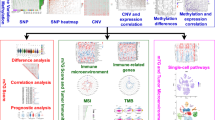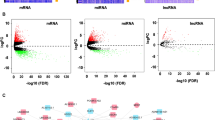Abstract
Background
RNASEH1 (Ribonuclease H1) encodes an endonuclease that specifically degrades the RNA of RNA–DNA hybrids and acts in DNA replication and repair. Although there are many studies on RNASEH1, the research of RNASEH1 in cancers is still insufficient. Therefore, in order to clarify the physiological mechanism of RNASEH1 in tumor cells, we evaluated the role of RNASEH1 by combining The Cancer Genome Atlas (TCGA) pan-cancer data and Genotype-Tissue Expression (GTEx) normal tissue data.
Methods
RNASEH1 expression was analyzed by using RNAseq data from TCGA and the GTEx database. The Human Protein Atlas (HPA), GeneCards and STRING database were used to explore the protein information of RNASEH1. The prognostic value of RNASEH1 was analyzed by using the clinical survival data from TCGA. Differential analysis of RNASEH1 in different cancers was performed by using R package “DESeq2”, and enrichment analysis of RNASEH1 was conducted by using R package “clusterProfiler”. We downloaded the immune cell infiltration score of TCGA samples from published articles and online databases, and the correlation analysis between immune cell infiltration levels and RNASEH1 expression was performed. Not only that, we further evaluated the association of RNASEH1 with immune activating genes, immunosuppressive genes, chemokines and chemokine receptors. At the end of the article, the differential expression of RNASEH1 in pan-cancer was validated by using GSE54129, GSE40595, GSE90627, GSE106937, GSE145976 and GSE18672, and qRT-PCR was also performed for verification.
Findings
RNASEH1 was significantly overexpressed in 19 cancers and the overexpression was closely correlated with poor prognosis. Moreover, the expression of RNASEH1 was significantly correlated with the regulation of the tumor microenvironment. In addition, RNASEH1 expression was closely associated with immune cell infiltration, immune checkpoints, immune activators, immunosuppressive factors, chemokines and chemokine receptors. Finally, RNASEH1 also was closely associated with DNA-related physiological activities and mitochondrial-related physiological activities.
Interpretation
Our studying suggests that RNASEH1 is a potential cancer biomarker. And RNASEH1 may be able to regulate the tumor microenvironment by regulating the relevant physiological activities of mitochondrial and thereby regulating the occurrence and development of tumors. Thus, it could be used to develop new-targeted drugs of tumor therapy.















Similar content being viewed by others
Data availability
The data used to support this study is available from the corresponding author upon request.
References
Bray F, Laversanne M, Weiderpass E, Soerjomataram I. The ever-increasing importance of cancer as a leading cause of premature death worldwide. Cancer. 2021;127:3029–30.
IARC-WHO, Key Cancer Data and Key Figures on IARC: 2020–2021. [Internet]. International Agency for Research on Cancer—World Health Organization. 2021. [cited 2023 Feb 27]. Available from: https://www.iarc.who.int/biennial-report-2020-2021web/.
Ribas A, Wolchok JD. Cancer immunotherapy using checkpoint blockade. Science. 2018;359:1350–5.
Topalian SL, Taube JM, Anders RA, Pardoll DM. Mechanism-driven biomarkers to guide immune checkpoint blockade in cancer therapy. Nat Rev Cancer. 2016;16:275–87.
Arneth B Tumor microenvironment. Medicina (Kaunas) 56 (2019).
Liu J, Lichtenberg T, Hoadley KA, Poisson LM, Lazar AJ, Cherniack AD, et al. An integrated TCGA pan-cancer clinical data resource to drive high-quality survival outcome analytics. Cell. 2018;173:400–16 (e11).
Wei R, Liu S, Zhang S, Min L, Zhu S. Cellular and extracellular components in tumor microenvironment and their application in early diagnosis of cancers. Anal Cell Pathol (Amst). 2020;2020:6283796.
Pitt JM, Marabelle A, Eggermont A, Soria JC, Kroemer G, Zitvogel L. Targeting the tumor microenvironment: removing obstruction to anticancer immune responses and immunotherapy. Ann Oncol. 2016;27:1482–92.
Wu T, Dai Y. Tumor microenvironment and therapeutic response. Cancer Lett. 2017;387:61–8.
Whiteside TL. The tumor microenvironment and its role in promoting tumor growth. Oncogene. 2008;27:5904–12.
Devkota L, Starosolski Z, Rivas CH, Stupin I, Annapragada A, Ghaghada KB, et al. Detection of response to tumor microenvironment-targeted cellular immunotherapy using nano-radiomics. Sci Adv. 2020;6:eaba6156.
Wu H, Lima WF, Crooke ST. Properties of cloned and expressed human RNase H1. J Biol Chem. 1999;274:28270–8.
Cerritelli SM, Frolova EG, Feng C, Grinberg A, Love PE, Crouch RJ. Failure to produce mitochondrial DNA results in embryonic lethality in Rnaseh1 null mice. Mol Cell. 2003;11:807–15.
Martinez-Outschoorn UE, Goldberg A, Lin Z, Ko YH, Flomenberg N, Wang C, et al. Anti-estrogen resistance in breast cancer is induced by the tumor microenvironment and can be overcome by inhibiting mitochondrial function in epithelial cancer cells. Cancer Biol Ther. 2011;12:924–38.
Bindea G, Mlecnik B, Tosolini M, Kirilovsky A, Waldner M, Obenauf AC, et al. Spatiotemporal dynamics of intratumoral immune cells reveal the immune landscape in human cancer. Immunity. 2013;39:782–95.
Hanzelmann S, Castelo R, Guinney J. GSVA: gene set variation analysis for microarray and RNA-seq data. BMC Bioinform. 2013;14:7.
Yu G, Wang LG, Han Y, He QY. clusterProfiler: an R package for comparing biological themes among gene clusters. OMICS. 2012;16:284–7.
Zhang Q, Liang Z, Gao Y, Teng M, Niu L. Differentially expressed mitochondrial genes in breast cancer cells: potential new targets for anti-cancer therapies. Gene. 2017;596:45–52.
Lopez MF, Kristal BS, Chernokalskaya E, Lazarev A, Shestopalov AI, Bogdanova A, et al. High-throughput profiling of the mitochondrial proteome using affinity fractionation and automation. Electrophoresis. 2000;21:3427–40.
Zong WX, Rabinowitz JD, White E. Mitochondria and cancer. Mol Cell. 2016;61:667–76.
Reyes A, Melchionda L, Nasca A, Carrara F, Lamantea E, Zanolini A, et al. RNASEH1 mutations impair mtDNA replication and cause adult-onset mitochondrial encephalomyopathy. Am J Hum Genet. 2015;97:186–93.
Carreno-Gago L, Blazquez-Bermejo C, Diaz-Manera J, Camara Y, Gallardo E, Marti R, et al. Identification and characterization of new RNASEH1 mutations associated with PEO syndrome and multiple mitochondrial DNA deletions. Front Genet. 2019;10:576.
Manini A, Caporali L, Meneri M, Zanotti S, Piga D, Arena IG, et al. Case report: rare homozygous RNASEH1 mutations associated with adult-onset mitochondrial encephalomyopathy and multiple mitochondrial DNA deletions. Front Genet. 2022;13: 906667.
Sachdev A, Fratter C, McMullan TFW. Novel mutation in the RNASEH1 gene in a chronic progressive external ophthalmoplegia patient. Can J Ophthalmol. 2018;53:e203–5.
Grzybowska-Szatkowska L, Slaska B. Mitochondrial DNA and carcinogenesis (review). Mol Med Rep. 2012;6:923–30.
Shortman K, Sathe P, Vremec D, Naik S, O’Keeffe M. Plasmacytoid dendritic cell development. Adv Immunol. 2013;120:105–26.
Matta BM, Castellaneta A, Thomson AW. Tolerogenic plasmacytoid DC. Eur J Immunol. 2010;40:2667–76.
de Saint Basile G, Menasche G, Fischer A. Molecular mechanisms of biogenesis and exocytosis of cytotoxic granules. Nat Rev Immunol. 2010;10:568–79.
Cooper MA, Fehniger TA, Caligiuri MA. The biology of human natural killer-cell subsets. Trends Immunol. 2001;22:633–40.
Poli A, Michel T, Theresine M, Andres E, Hentges F, Zimmer J. CD56bright natural killer (NK) cells: an important NK cell subset. Immunology. 2009;126:458–65.
Luine VN. Estradiol and cognitive function: past, present and future. Horm Behav. 2014;66:602–18.
Bogathy E, Papp N, Vas S, Bagdy G, Tothfalusi L. AM-251, a cannabinoid antagonist, modifies the dynamics of sleep-wake cycles in rats. Front Pharmacol. 2019;10:831.
Weringa T, van Dam K, Bos MP, van Putten JP, Krans HM. The effects of 1-methyl-3-isobutylxanthine on insulin-sensitive 2-deoxyglucose transport. Biochim Biophys Acta. 1984;803:123–8.
Ho CM, Wu HL, Ho ST, Wang JJ. Dexamethasone prevents postoperative nausea and vomiting: benefit versus risk. Acta Anaesthesiol Taiwan. 2011;49:100–4.
Acknowledgements
We gratefully acknowledge the financial supports from the PhD fellowship of Nanchang Hangkong University (EA202008259), Natural Science Foundation of Hubei Province (2019CFB391).
Author information
Authors and Affiliations
Corresponding author
Ethics declarations
Conflicts of interest
The authors declare that there is no conflict of interest regarding the publication of this paper.
Ethical approval
The study was approved by the Committee on Human Research of Maternal and Child Health Hospital of Hubei Province (2020IECXM045). All research was performed in accordance with relevant guidelines and regulations.
Informed consent
Informed consent was obtained from all participants.
Additional information
Publisher's Note
Springer Nature remains neutral with regard to jurisdictional claims in published maps and institutional affiliations.
Supplementary Information
Below is the link to the electronic supplementary material.
Rights and permissions
Springer Nature or its licensor (e.g. a society or other partner) holds exclusive rights to this article under a publishing agreement with the author(s) or other rightsholder(s); author self-archiving of the accepted manuscript version of this article is solely governed by the terms of such publishing agreement and applicable law.
About this article
Cite this article
Yi, C., Yang, J., Zhang, T. et al. A pan-cancer analysis of RNASEH1, a potential regulator of the tumor microenvironment. Clin Transl Oncol 25, 2569–2586 (2023). https://doi.org/10.1007/s12094-023-03142-4
Received:
Accepted:
Published:
Issue Date:
DOI: https://doi.org/10.1007/s12094-023-03142-4




